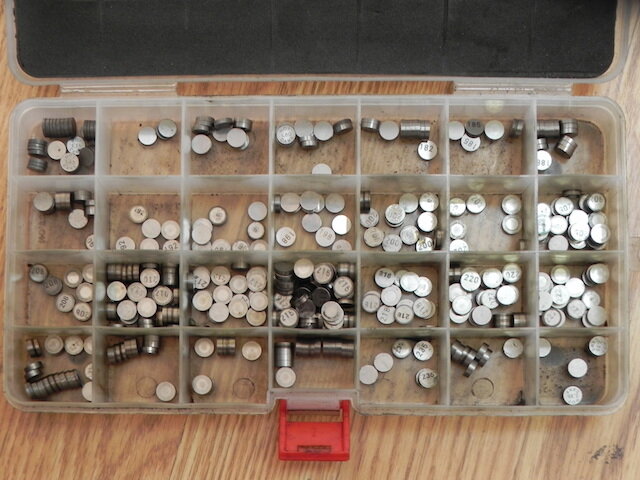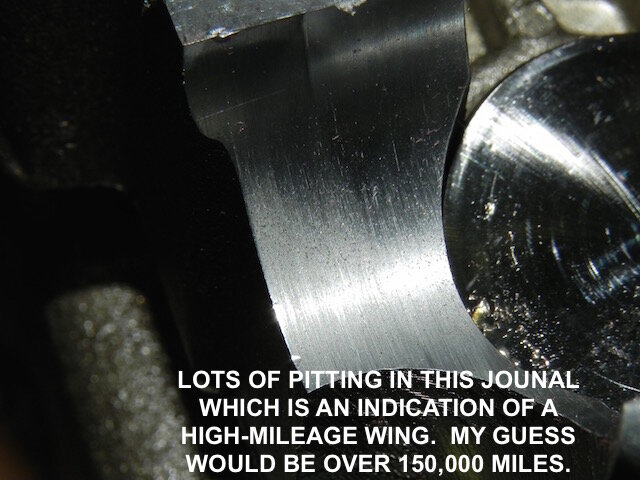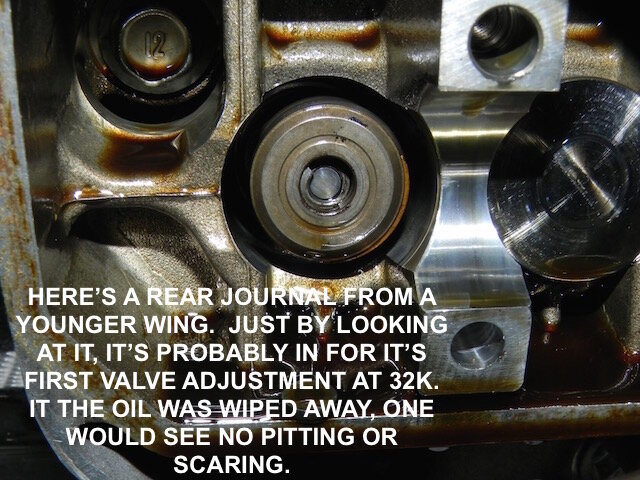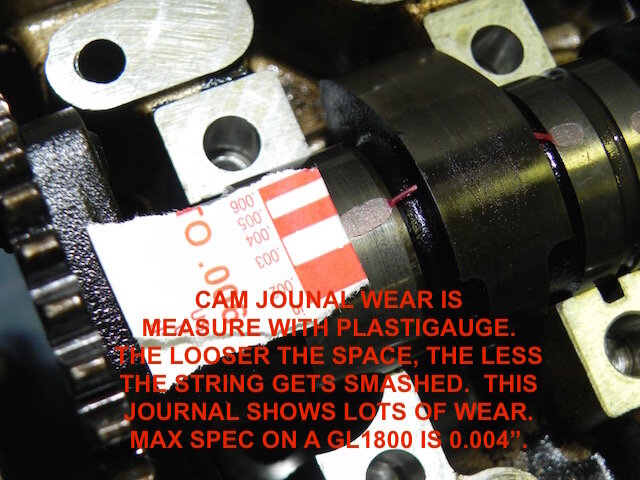Yesterday I brought my Gold Wing trike to the Honda dealer for the 32,000 mile valve check. When I picked it up today not one valve was out of spec. It cost me $300.00 to find that out. I guess it is a peace of mind payment. Is it normal to not have any valves out of spec?
Navigation
Install the app
How to install the app on iOS
Follow along with the video below to see how to install our site as a web app on your home screen.
Note: This feature may not be available in some browsers.
More options
You are using an out of date browser. It may not display this or other websites correctly.
You should upgrade or use an alternative browser.
You should upgrade or use an alternative browser.
Valve Check
- Thread starter 3 for 2
- Start date
Not unusual. When I had my '06 checked around 32k miles, I had one valve .001 out.
Not unusual. When I had my '06 checked around 32k miles, I had one valve .001 out.
Is it your plan to do it every 32K miles?
Is it your plan to do it every 32K miles?
Nope. Was told by my Gold Wing mechanic that if I wasn't racing and running red line often then probably no need.
I use a former Honda mechanic that's been in business for himself for many many years and he says check the valves at 90K. I had them checked at 83K because it was easier for me and I had one valve snug center spec and one that was just barely loose center spec. I plan on getting my '13 trike checked around the same time. BTW I never check the valves in my cages regardless of the miles just curious as to why a bike needs it so often. I run all those engines around the same RPM most of the time.
I use a former Honda mechanic that's been in business for himself for many many years and he says check the valves at 90K. I had them checked at 83K because it was easier for me and I had one valve snug center spec and one that was just barely loose center spec. I plan on getting my '13 trike checked around the same time. BTW I never check the valves in my cages regardless of the miles just curious as to why a bike needs it so often. I run all those engines around the same RPM most of the time.
Different valve train designs
GoldWingrGreg
<b>JustWings.com</>
I often find them in spec at 32k. However, spec means that they are within their +- of 0.001". Here is the problem with them being in spec. It means that they are within spec on that day, but maintenance is about paying forward. In other wards, the intension is for them to still be in spec at 64k, which is the next time their valve gaps need inspection. They should never fall out of the +-spec range.
Here is why Honda says to inspect them every 32k. I'll use an intake valve as an example. Its spec is 0.006" +- 0.001. So, at any given time the gap should never be below 0.005 or wider then 0.007. The engineers that design our engine know that the most a gap will change during normal use in any given 32,000 mile period is 0.001". Therefore, if your "valve inspection" leaves an intake valve in spec at 0.005" it means that at 64k the gap could lesson to 0.004 placing it out of spec for an unknown amount of miles ridden. A valve out of spec can cause valve damage.
When I do valve adjustments, my goal is to center spec them all. My customers will make comments like ... it starts quicker, it seems to "hum" and run smoother at freeway speeds, my throttle is noticeably snappier, or my mpg greatly improved. On some trikes that have modified exhaust, there will be less back firing. Which is what I would expect to hear. After all, valves that are set at their center spec means that equal amounts of air/fuel mixture is provided for each explosion as well as an equal amount of exhaust exits. Basically ... combustion from cylinder to cylinder is equal.
Unfortunately, many shops do not have an ample supply of shims in stock, and are not willing to tie up a bay for 3 days while they wait on a $7.25 shim. Often shops have production per bay goals of like a $1000 of labor per bay. Having a Wing tie up a bay for 3 days while waiting on a $7.25 shim does not financially work for its owners.
Another issue is shim inventory. As of Dec 31, 2016 the retail value of my shim inventory is $3059.50. If your shop sells chrome, many shop owners would rather invest their money in chrome instead of shims. After all, chrome is more shinny. In my case, I sell no accessories and provide only service. A completely different concept then most shops. I'm also the only GL1800 specialized service center in the world. A shop like mine is a real shop ... it survives solely on providing good, quality service and not making a Wing shinny.

Here is why Honda says to inspect them every 32k. I'll use an intake valve as an example. Its spec is 0.006" +- 0.001. So, at any given time the gap should never be below 0.005 or wider then 0.007. The engineers that design our engine know that the most a gap will change during normal use in any given 32,000 mile period is 0.001". Therefore, if your "valve inspection" leaves an intake valve in spec at 0.005" it means that at 64k the gap could lesson to 0.004 placing it out of spec for an unknown amount of miles ridden. A valve out of spec can cause valve damage.
When I do valve adjustments, my goal is to center spec them all. My customers will make comments like ... it starts quicker, it seems to "hum" and run smoother at freeway speeds, my throttle is noticeably snappier, or my mpg greatly improved. On some trikes that have modified exhaust, there will be less back firing. Which is what I would expect to hear. After all, valves that are set at their center spec means that equal amounts of air/fuel mixture is provided for each explosion as well as an equal amount of exhaust exits. Basically ... combustion from cylinder to cylinder is equal.
Unfortunately, many shops do not have an ample supply of shims in stock, and are not willing to tie up a bay for 3 days while they wait on a $7.25 shim. Often shops have production per bay goals of like a $1000 of labor per bay. Having a Wing tie up a bay for 3 days while waiting on a $7.25 shim does not financially work for its owners.
Another issue is shim inventory. As of Dec 31, 2016 the retail value of my shim inventory is $3059.50. If your shop sells chrome, many shop owners would rather invest their money in chrome instead of shims. After all, chrome is more shinny. In my case, I sell no accessories and provide only service. A completely different concept then most shops. I'm also the only GL1800 specialized service center in the world. A shop like mine is a real shop ... it survives solely on providing good, quality service and not making a Wing shinny.

No problem with anything said here, not that you need my approval just saying Thanks for your going the extra mile.
If I enrolled in a certified Honda mechanic program would they teach this "centering" of the valve technique?
Are valve shims reusable?.............I think I know your answer but can they be measured to check for wear. Then reused?
If I enrolled in a certified Honda mechanic program would they teach this "centering" of the valve technique?
Are valve shims reusable?.............I think I know your answer but can they be measured to check for wear. Then reused?
GoldWingrGreg
<b>JustWings.com</>
If I enrolled in a certified Honda mechanic program would they teach this "centering" of the valve technique?
Are valve shims reusable?.............I think I know your answer but can they be measured to check for wear. Then reused?
I cannot answer the certified Honda centering of the valve thing; however, it was taught in my 4 years of automotive shop classes, and in the small engine coarse that I once took (lawn mower engines up to 5hp) . My education came from 2 years in the best high auto shop program in the country, and 2 years at a community collage while working as an apprentice to become a journeyman auto mechanic. The theory of wanting equal explosion is gonna run universal on all internal combustion engines. It the same reason equal spark and air/fuel mixture is needed for a good running engine. Basically any internal combustion text book will teach the same ... after all, this is not rocket science.
Valve shims are made of a really hard metal and are reusable. On GL1800 it's mainly the aluminum cam journals that wear causing our valves to need adjusting. Many might think it's a wearing valve seat that causes the need for adjustment. Which was true in the old day of non-over head cam motor. Back then an extremely strong valve spring was used to push a valve closed. To do that a heavy lifter needed to be pushed on, a push rod, a rocker arm, and a heavy valve. Basically, the spring pressure pounded a valve closed ... thus valve seat wear. However, GL1800 have an over head cam minus almost all of those moving parts. Valve spring pressure is very little. It is so little, I can open and close a valve with my thumb. Thus, a valve is not being "rammed" closed and into a valve seat.
Another reason valves need adjusted is for their longevity. Those same engineers I discussed above also know this. That a valve has to be seated for a long enough period of time (milli seconds) for heat to transfer out of it and into its valve seat. To wide of gap it is closed for longer, to small of gap, and it is closed for a shorter period of time. A shorter period of time means less time for heat to transfer. The outer tip of an exhaust valve is the hottest part in the whole engine. Like 1400-1800 deg. A valve staying to hot can become burnt. A burnt valve that no longer closes correctly means poor compression and a loss of power out of that cylinder. It should be noted here that I've never had to do head work because of a burnt valve on a GL1800. Thus, the value of a valve adjustment on our machines is really noticed by the rider noticing improved performance conditions as stated in post #7.
Below are pictures of normal wear on some cam journals and shows why valve adjustment is needed.



Plastigage is a special, precision, waxed string used to measure gaps.
A new Wing's valve journal gap is around 0.001". The above wear happens from use, how it's used, and maintained. Frequent oil, oil filter, and air filter changes slow down such wear.
Thanks for taking the time to post this informative stuff. Might not always agree with you 100% but that don't always mean you're the one wrong . Still have some differences with you on the drive shaft discussions we had going. Sorry it took so long for me to get back. I usually look at most stuff on phone but wanted a closer look at your valve train pics thus I got on my OLD vista computer.
. Still have some differences with you on the drive shaft discussions we had going. Sorry it took so long for me to get back. I usually look at most stuff on phone but wanted a closer look at your valve train pics thus I got on my OLD vista computer. 
Back a few years ago it seem like we were told the 903 Kaw. shims could be used over but they were much larger that the Gold Wing shims. My friend had a 903 and I think his mechanic told him they were supposed to check them with a straight edge for dishing before reuse. That's been many years ago so I won't say that's gospel. 903 nice bike for sure but that thing had roller crank bearings. My friend put a typical automotive oil pressure gauge on his and it scared him to death, it didn't move. They just didn't need any pressure in the lower end. He finally ordered a gauge for the 903 so at least he'd see it move when he started the engine. Let the Good Times Roll
You show pictures of a high mileage journal with lot of pitting. You label it Normal! Is there anything that could have been done to prevent (help lessen) that? Was this journal reused when the bike was reassembled?
Thanks in Advance
Back a few years ago it seem like we were told the 903 Kaw. shims could be used over but they were much larger that the Gold Wing shims. My friend had a 903 and I think his mechanic told him they were supposed to check them with a straight edge for dishing before reuse. That's been many years ago so I won't say that's gospel. 903 nice bike for sure but that thing had roller crank bearings. My friend put a typical automotive oil pressure gauge on his and it scared him to death, it didn't move. They just didn't need any pressure in the lower end. He finally ordered a gauge for the 903 so at least he'd see it move when he started the engine. Let the Good Times Roll
You show pictures of a high mileage journal with lot of pitting. You label it Normal! Is there anything that could have been done to prevent (help lessen) that? Was this journal reused when the bike was reassembled?
Thanks in Advance
GoldWingrGreg
<b>JustWings.com</>
Thanks for taking the time to post this informative stuff. Might not always agree with you 100% but that don't always mean you're the one wrong. Still have some differences with you on the drive shaft discussions we had going. Sorry it took so long for me to get back. I usually look at most stuff on phone but wanted a closer look at your valve train pics thus I got on my OLD vista computer.

Back a few years ago it seem like we were told the 903 Kaw. shims could be used over but they were much larger that the Gold Wing shims.
You show pictures of a high mileage journal with lot of pitting. You label it Normal! Is there anything that could have been done to prevent (help lessen) that? Was this journal reused when the bike was reassembled?
Thanks in Advance
Not sure what other bikes or cars GL1800 shims might fit. They are known as a 7.48mm diameter shim. Honda makes them in many thicknesses, but generally GL1800 use the ones from 180-230mm. Their surface is flat and not curved. I'm sure other Honda m/c use them, and would bet that in the Honda m/c world there could be 2 or 3 diameters used.
As for "normal" wear in a cam journal. I believe the picture with all the pitting came from a head that was not reused. I'm sure it came off the fastest GL1800 running the Gap. In that head's case, it came from an extremely well maintained Wing, but one that road hard. It had oil and filter changes every 4k. Air filter, brake and clutch fluid every 12k. The guy who rides that Wing is on the ground inspecting it prior to riding for the day. Air pressure is adjusted daily.
The head had a hard life for it first 75k, then the rider started perfecting his riding skills to become the fastest riding a GL1800 on the Gap. To be the fastest requires running in 2nd and 3rd all the time at 5500-6500rpm. A set of tires lasts him about 1,000 miles. To me that journal falls in an extreme use category ... thus all the pitting and a Plastigage reading of 0.003". That same head on your Wing or my Wing with 150k would show less pitting and would Plastigage out at probably 0.002", and it would probably be that way easily past 200k.
As for how to have less internal engine wear. Frequent oil changes using a proper oil and oil filter. On a GL1800, there is nothing wrong with using Honda cheapest oil GN-4. Every time I bring an engine to my engine machinist, and we talk about wear, he constantly harps frequent oil changes. Every time I bring up synthetic oils, he says the answer is frequent oil changes. Certainly, how a person rides, uses their m/c, and where they ride is all a factor too.
Lets go back to the bike that had that head. The first time I met that rider was when he had a failing ADG (alternator drive gear). I did an oil pressure test prior to the repair, and the oil filter was causing a low reading (spec: oil hot, 5,000 rpms, oil pressure should be 76psi). His pressure was 10-12psi low. He was running a Purolator Pure 1 with Rotella full synthetic oil. Using an incorrect oil filter and a non-m/c specific oil can cause excessive wear too.
Sorry if I'm off topic here, but this might be a good time to discuss oil filters
FYI ... if one works on enough GL1800s and that person, for various reasons does occasional oil pressure tests, they might learn to trust very few oil filters. Thus far, Purolators Pure 1, Bosch 3300, and a K&N oil filters have all failed an oil pressure test. Also, many are tested and have a Honda's oil filter on it, and thus far the Honda filter always pass. Guess which one I always install ??? For other reasons, it's gotten to the point where I only trust Honda oils.
Hey Greg, how about a fram oil filter?
Greg, your thoughts on oil change intervals? We know the book says 8k miles... too long IMO. I try to change every 5k miles, but do sometimes go over on longer trips.
Motor oils.. A honda dealer is 20 miles away, WalMart is only 6 miles. I use a motor oil that meets Honda JASO specs (Rotella T6). I used Mobil 1 4T until it's price went to $40 a gallon, before that I used dino Rotella, until a reformulation, and they dropped the JASO spec. I use Mobil 1 motorcycle specific oil filters, MC-134.
I use a motor oil that meets Honda JASO specs (Rotella T6). I used Mobil 1 4T until it's price went to $40 a gallon, before that I used dino Rotella, until a reformulation, and they dropped the JASO spec. I use Mobil 1 motorcycle specific oil filters, MC-134.
All that to say, I've never had an oil related failure in many 'Wings & Valkyries. And, we ride in all types of weather, from cold to very hot temps. But I'd sure like this one to last as long as possible.
Motor oils.. A honda dealer is 20 miles away, WalMart is only 6 miles.
All that to say, I've never had an oil related failure in many 'Wings & Valkyries. And, we ride in all types of weather, from cold to very hot temps. But I'd sure like this one to last as long as possible.
GoldWingrGreg
<b>JustWings.com</>
Hey Greg, how about a fram oil filter?
According to Fram, the filter for a GL1800 is PH6017A. So long as you are using that one, you should be good.
GoldWingrGreg
<b>JustWings.com</>
Greg, your thoughts on oil change intervals?
Like you, when on long trips, I will push my oil to 8,000 miles. When not on long trips, I change mine every 4k and here is why. No matter what oil a person uses, GL1800 transmissions get more clunky when the oil is about 6-6,500 miles old. The oil break down is called shearing. Because I don't like that clunk, I change mine more frequent.
GL1800 transmissions like fresh oil and cold climate. They shift best under those conditions.
Thanks. Yeah, I've noticed the clunk on the Valkyries I've had. I guess this 'Wing, I've kept it changed often enough that I've not heard it. I changed it today, at barely 3800 miles, we're headed for the NM mountains tomorrow. Too damn hot here... for man OR machine. :laugh:
Marc H
4250+ Posts
I've noticed on both my wing and nomad that I can tell a difference in how it shifts when the oil change is coming up.
GoldWingrGreg
<b>JustWings.com</>
I've noticed on both my wing and nomad that I can tell a difference in how it shifts when the oil change is coming up.
Some will change oils brands or weights and then "ooh and ahh" on how they like the new oil. What they are probably feeling is the difference of fresh oil.
Trike Talk Community
Welcome to a community dedicated to the most diverse and fastest growing powersports segment, Motorcycle Trikes. Come join the discussion about the best makes and models, popular modifications and proven performance hacks, trike touring and travel, maintenance, meetups and more!
Register Already a member? LoginForum statistics






